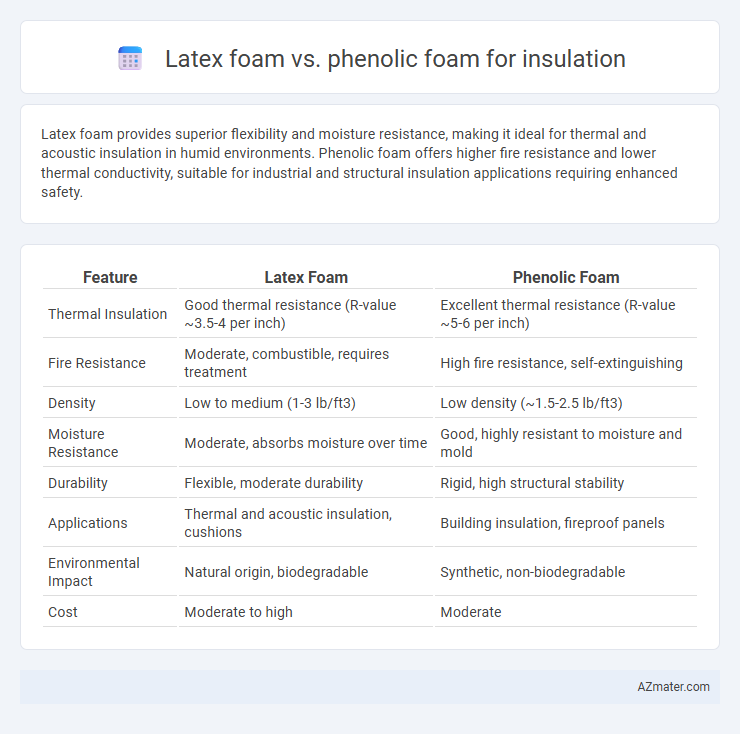Latex foam provides superior flexibility and moisture resistance, making it ideal for thermal and acoustic insulation in humid environments. Phenolic foam offers higher fire resistance and lower thermal conductivity, suitable for industrial and structural insulation applications requiring enhanced safety.
Table of Comparison
| Feature | Latex Foam | Phenolic Foam |
|---|---|---|
| Thermal Insulation | Good thermal resistance (R-value ~3.5-4 per inch) | Excellent thermal resistance (R-value ~5-6 per inch) |
| Fire Resistance | Moderate, combustible, requires treatment | High fire resistance, self-extinguishing |
| Density | Low to medium (1-3 lb/ft3) | Low density (~1.5-2.5 lb/ft3) |
| Moisture Resistance | Moderate, absorbs moisture over time | Good, highly resistant to moisture and mold |
| Durability | Flexible, moderate durability | Rigid, high structural stability |
| Applications | Thermal and acoustic insulation, cushions | Building insulation, fireproof panels |
| Environmental Impact | Natural origin, biodegradable | Synthetic, non-biodegradable |
| Cost | Moderate to high | Moderate |
Overview of Latex Foam and Phenolic Foam
Latex foam offers excellent flexibility, durability, and moisture resistance, making it ideal for thermal and acoustic insulation in residential and commercial buildings. Phenolic foam features a rigid structure with high fire resistance and low smoke emission, providing superior thermal insulation and enhanced safety in industrial and high-risk environments. Both foams are valued for their energy efficiency, but latex foam excels in comfort applications, while phenolic foam is preferred for stringent fire codes and structural integrity.
Key Physical Properties Comparison
Latex foam offers superior flexibility and resilience with a typical density range of 40-70 kg/m3, while phenolic foam is denser, usually between 50-100 kg/m3, providing enhanced compressive strength and rigidity. Phenolic foam excels in thermal insulation with lower thermal conductivity values around 0.018-0.025 W/m*K, compared to latex foam's 0.035-0.045 W/m*K, making it more effective for minimizing heat transfer. Fire resistance is significantly higher in phenolic foam due to its inherently low smoke development and self-extinguishing properties, whereas latex foam is more flammable and produces denser smoke during combustion.
Thermal Insulation Performance
Latex foam offers excellent thermal insulation performance due to its closed-cell structure, providing low thermal conductivity and effective heat resistance. Phenolic foam excels in fire resistance and maintains thermal insulation efficiency at higher temperatures, with a thermal conductivity typically ranging between 0.018 and 0.025 W/m*K. Both materials perform well in insulation applications, but phenolic foam often outperforms latex foam in extreme heat conditions and fire safety standards.
Fire Resistance and Safety Ratings
Latex foam offers moderate fire resistance but typically requires chemical additives to meet safety ratings for insulation, whereas phenolic foam inherently provides superior fire resistance with low flame spread and smoke development properties. Phenolic foam's high charring rate and low heat release make it a preferred choice for applications demanding stringent fire safety standards such as in building insulation and industrial environments. Fire safety certifications like ASTM E84 and UL 94 commonly rate phenolic foam higher than latex foam, reflecting its enhanced performance in preventing fire propagation and toxic smoke emission.
Durability and Lifespan
Latex foam offers moderate durability with resistance to moisture and mold, maintaining performance for approximately 10-15 years in insulation applications. Phenolic foam exhibits superior durability due to its high thermal stability and chemical resistance, often lasting beyond 25 years without degradation. Phenolic foam's rigid structure and fire-retardant properties contribute to a longer lifespan compared to the more flexible and moisture-sensitive latex foam.
Moisture and Mold Resistance
Latex foam exhibits superior moisture resistance due to its closed-cell structure, minimizing water absorption and reducing mold growth risk in insulation applications. Phenolic foam, while offering excellent thermal insulation and fire resistance, tends to absorb more moisture, increasing vulnerability to mold and compromising insulation performance over time. Selecting latex foam ensures enhanced durability in damp environments, whereas phenolic foam may require additional moisture barriers for optimal mold prevention.
Environmental Impact and Sustainability
Latex foam insulation is derived from natural rubber, making it biodegradable and renewable with a lower carbon footprint compared to phenolic foam, which is synthesized from petrochemicals and involves more energy-intensive production processes. Phenolic foam offers excellent thermal resistance but generates harmful formaldehyde emissions during manufacturing and disposal, posing environmental and health concerns. Latex foam's eco-friendliness and recyclability position it as a more sustainable option for green building applications.
Health and Indoor Air Quality Considerations
Latex foam insulation offers superior breathability and low VOC emissions, promoting healthier indoor air quality by reducing the presence of harmful chemicals and allergens compared to phenolic foam. Phenolic foam, while providing excellent thermal resistance, may off-gas formaldehyde and other volatile organic compounds, posing potential respiratory risks in enclosed environments. Choosing latex foam contributes to improved indoor air quality and overall occupant health by minimizing exposure to toxic emissions commonly associated with phenolic foam insulation.
Installation Ease and Application Areas
Latex foam offers superior flexibility and ease of installation, making it ideal for irregular surfaces in residential and commercial insulation. Phenolic foam features high fire resistance and low thermal conductivity, commonly used in industrial applications and HVAC systems despite its more rigid and brittle nature during installation. Choosing between latex and phenolic foam depends on project requirements such as fire safety standards, surface adaptability, and thermal efficiency.
Cost Analysis and Value for Money
Latex foam insulation generally incurs higher upfront costs compared to phenolic foam due to its natural latex base and superior elasticity, offering enhanced durability and comfort in applications like bedding and soundproofing. Phenolic foam, favored for its exceptional fire resistance and thermal insulation properties, provides a cost-effective solution with competitive R-values per inch, making it ideal for commercial construction and industrial use. The value for money depends on project priorities: latex foam delivers long-term performance and environmental benefits, whereas phenolic foam excels in meeting stringent safety standards at a lower material cost.

Infographic: Latex foam vs Phenolic foam for Insulation
 azmater.com
azmater.com